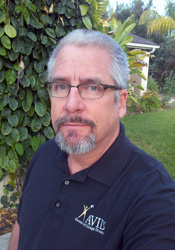 By Bill Madigan
By Bill Madigan
On a recent vacation I found myself lost in a medieval area of Barcelona, Spain. My wife, Gary Kroesch (an AVID original) and I were trying to find a highly recommended “Tapas” restaurant. The roads, unlike my familiar downtown San Diego were twisted, curved and nestled among them were very few straight thoroughfares. In great contrast to what we expect here in our relatively modern cities, there were few if any street signs. Picture all three of us gawking about looking for the “third left turn after the bronze statue of the pig!” We were the quintessential lost tourists. Some of the roads were as small as sidewalks between tall, brick tenements built in the 15th century and some were the size of a small alleys. We found ourselves in the same place twice after walking for half an hour, in spite of the fact that we all KNEW where the pig statue was! Finally, with the help of my shabby Spanish skills, we stumbled on our destination, the storied “La Ribera.” We were later laughed at for counting the tinier paths as roads. Considering the positive, we were at least more hungry and relieved. Our problem was we had American city schemas in our brains, all parallels and perpendiculars. We carried our mental graph-paper maps and held them up to the “spaghetti” of roads fashioned 600 years ago, only to feel ever more lost.
Most of our students will face this same kind of confusion and disorientation as they eventually enter our ever-changing “global economy.” Considering the radical pace of technological and economic change, we need a new, quick reassessment of what we teach in order to best guide our students. Take “Newsweek” magazine for example – the paper, hardcopy. Ten years ago its editorials would often affect political debate and public opinion. Today, however, journalistic cognoscenti say this journalistic force will be gone in a few short years. In addition, newspapers are dwindling in number, circulation and influence, so what do you tell your journalism students? How are they to adjust? We educators have fretted over the last few years of economic uncertainty. Yet many professions are not only losing job numbers, they are disappearing!
Recently, a staff writer for the local “San Diego Union-Tribune” asked me to proofread an article by directing me to her blog to read it. On her site I noticed in the top right corner the words, “Please donate money.” I dropped my head in pathetic empathy. Her painful attempt to “monetize” her work says more about what she was not taught in school than it does about her capacities or intelligence. We educators taught her how to be a writer but not how to be a marketer, a tech-savvy web creator, or a problem solver. We trained her in a linear sequential way: you like writing, so take journalism class; then apply to a university known for journalism; then graduate, and with your connections find a job with some publication. One thing follows another; it’s a linear approach to learning. Our education systems are built this way. In other words, we are sending students to Barcelona with maps of San Diego! We are giving them a linear “stairway to heaven” as a tool to navigate an organic, twisted, and nuanced landscape. We have taught and trained them to be deft on a flat, concrete pathway, yet, when they graduate, they have to walk the rocking deck of a ship at sea in a storm of change. This new professional landscape is increasingly true of other disciplines such as law, accounting, medicine, and even the U.S. mail service. Linear skills are now being done better, cheaper, and faster by computers. Consequently, we desperately need to change how and what we teach for our students’ sake and for our nation.